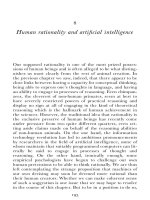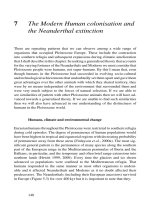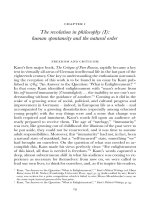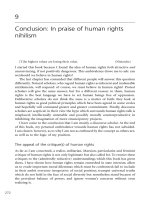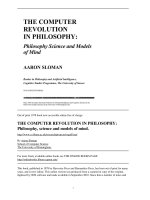The revolution in philosophy (I) - human spontaneity and the natural order
Bạn đang xem bản rút gọn của tài liệu. Xem và tải ngay bản đầy đủ của tài liệu tại đây (225.97 KB, 26 trang )
The revolution in philosophy (I):
human spontaneity and the natural order
Kant’s first major book, The Critique of Pure Reason, rapidly became a key
text in virtually all areas of German intellectual life in the last part of the
eighteenth century. One key to understanding the enthusiasmsurround-
ing the reception of this work is to be found in an essay by Kant pub-
lished in : “An Answer to the Question: ‘What is Enlightenment?’ ”
In that essay Kant identified enlightenment with “man’s release from
his self-incurred immaturity (Unm¨undigkeit) ...the inability to use one’s un-
derstanding without the guidance of another.”
Coming as it did in the
wake of a growing sense of social, political, and cultural progress and
improvement in Germany – indeed, in European life as a whole – and
accompanied by a growing dissatisfaction (especially among educated
young people) with the way things were and a sense that change was
both required and imminent, Kant’s words fell upon an audience al-
ready prepared to receive them. The age of “tutelage,” “immaturity”
was over, like growing out of childhood: the illusions of the past were to
be put aside, they could not be resurrected, and it was time to assume
adult responsibilities. Moreover, this “immaturity” had not, in fact, been
a natural state of mankind, but a “self-incurred” state, something “we”
had brought on ourselves. On the question of what was needed to ac-
complish this, Kant made his views perfectly clear: “For enlightenment
of this kind, all that is needed is freedom.”
Kant’s words captured a
deep, almost subterranean shift in what his audience was coming to ex-
perience as necessary for themselves: from now on, we were called to
lead our own lives, to think for ourselves, and, as if to inspire his readers,
Kant, “An Answer to the Question: ‘What is Enlightenment?,’ ” Kant’s Political Writings (ed. Hans
Reiss; trans. H. B. Nisbet) (Cambridge University Press, ), p. (italics added by me.) Kant’s
essay was written for a prize competition which it failed to win; Moses Mendelssohn’s essay on
the same topic instead garnered the first prize.
Kant, “An Answer to the Question: ‘What is Enlightenment?,’ ” Kant’s Political Writings,p..
Part I Kant and the revolution in philosophy
Kant claimed that all that was required for this to come about was to
have the “courage” to do so.
Dominating the Critique is the sense that, fromnow on, “we” moderns
had to depend on ourselves and our own critical powers to figure things
out. The opposite of such a “critical” (or, more accurately, self-critical)
stance is “dogmatism,” the procedure of simply taking some set of prin-
ciples for granted without having first subjected themto that kind of rad-
ical criticism.
In the Critique, Kant in fact characterizes “dogmatism” as
marking, as he puts it, the “infancy of reason” just as skepticism marks its
growth (although not its full maturity).
The point is not to remain in the
“self-incurred tutelage” of our cultural infancy, nor to be content simply
with the “resting place” that skepticismoffers us. It is instead to find a
home for our self-critical endeavors, a “dwelling point,” a Wohnplatz,ashe
put it, for ourselves.
Such a radical, thoroughgoing self-critical project
demands nothing less than that reason must, as Kant put it, “in all its
undertakings subject itself to criticism ...[and that] reason depends on
this freedom for its very existence”
; and, as such, “reason” must claim
“insight only into that which it produces after a plan of its own, and that
Immanuel Kant, Critique of Pure Reason (trans. N. K. Smith) (London: Macmillan and Co., ),
xxxv, p. . Dogmatism is defined early in the Critique by Kant as “the presumption that
it is possible to make progress with pure knowledge, according to principles, from concepts
alone ...without having first investigated in what way and by what right reason has come into
possession of these concepts.”
Critique of Pure Reason, = ;p.: “The first step in matters of pure reason, marking
its infancy, is dogmatic. The second step is sceptical; and indicates that experience has rendered
our judgment wiser and more circumspect. But a third step, such as can be taken only by fully
matured judgment, based on assured principles of proved universality, is now necessary, namely, to
subject to examination, not the facts of reason, but reason itself, in the whole extent of its powers,
and as regards its aptitude for pure a priori modes of knowledge. This is not the censorship but
the criticism of reason, whereby not its present bounds but its determinate [and necessary] limits,
not its ignorance on this or that point but its ignorance in regard to all possible questions of a
certain kind, are demonstrated from principles, and not merely arrived at by way of conjecture.”
Kant published two editions of the Critique of Pure Reason in and . There were substantial
changes in the second edition, and scholars continue to argue about the ways some very crucial
issues seemto be treated differently in the two editions, which in turn leads to arguments about
the alleged superiority of one edition over another, their mutual consistency or lack of consistency,
and so forth. In the notes, I follow the long and well-established practice of citing both editions:
the edition as the A edition, and the edition as the B edition.
Critique of Pure Reason, = : “Scepticismis thus a resting-place for human reason, where it
can reflect upon its dogmatic wanderings and make survey of the region in which it finds itself, so
that for the future it may be able to choose its path with more certainty. But it is no dwelling-place
for permanent settlement.”
Critique of Pure Reason: = . “Die Vernunft muß sich in allen ihren Unternehmungen der
Kritik unterwerfen ...Auf diese Freiheit beruht sogar die Existenz der Vernunft” (italics added
by me). This conception of the role of reason in Kant’s work has been particularly highlighted and
defended by Onora O’Neill in a variety of places. See for example the essays in Onora O’Neill,
Constructions of Reason: Explorations of Kant’s Practical Philosophy (Cambridge University Press, ).
My discussion, of course, is highly indebted to her own.
(I): Human spontaneity and the natural order
it must not allow itself to be kept, as it were, in nature’s leading-strings,
but must itself show the way with principles of judgment based upon
fixed laws, constraining nature to give answer to questions of reason’s
own determining.”
If however, the themes of “freedom” and the “thinking for oneself ”
were indeed motivating the Critique, one could nonetheless excuse any
reader who found themsomewhat hard to find in its opening parts. In
those initial chapters, Kant set forth what might look like some rather
arcane arguments about the logical nature of the kinds of judgments
we made and their relation to the concerns of traditional metaphysics.
Traditional metaphysics studied those things that were “transcendent”
to our experience in the sense that we were said to be “aware” of them
without being able in any pedestrian way to experience them. Thus,
so it was said, while we might empirically study stones, grass, the seas,
and even our own bodies and psyches in a directly experiential way,
traditional metaphysics claimed to study with necessity and certainty a
realmof objects that were not available to such ordinary experiential
encounters, such as God and the eternal soul, and thus, metaphysics was
said to be a discipline employing only “pure reason” unfettered by any
connection or dependence on experience. The judgments of metaphysics
were therefore dependent on what “pure” reason turned up and could
not be falsified by any ordinary use of experience.
Kant was treading on some fairly controversial territory, and he very
deftly raised the issue of the authority possessed by such “metaphysics”
(as the non-empirical study by pure reason of such transcendent objects)
by laying out and examining a typology of the judgments that we make.
There are two ways, Kant suggested, that we can look at judgments: on
the one hand, we can regard the form of the judgment (how the subject
is related to the predicate); and, on the other hand, we can regard the
judgment in terms of how we go about justifying it.
With regard to form, judgments can be said to be, in Kant’s technical
language, either “analytic” or “synthetic.” An analytic judgment is one
in which the predicate is said to be “contained” in the subject (as a smaller
circle might be drawn inside a larger circle). “Triangles have three sides”
Critique of Pure Reason, xiii: “Sie begriffen, daß die Vernunft nur das einsieht, was sie selbst nach
ihremEntw¨urfe hervorbringt, daß sie mit Prinzipien ihrer Urteile nach best¨andigen Gesetzen
vorangehen und die Natur n¨otigen m¨usse, auf ihre Fragen zu antworten, nicht aber sich von ihr
allein gleichsamamLeitbande g¨angeln lassen m¨usse.”
Part I Kant and the revolution in philosophy
would be an analytic judgment, since the predicate (“three sides”) is
already “contained” in the subject (“triangles”). Thus, one of the marks
of an analytic judgment is that it would always be a self-contradiction to
deny it. (“A triangle does not have three sides” would be an example of
such a self-contradiction.) Synthetic judgments, by contrast, do not have
the predicate “contained” in the subject, and thus it would never be a
self-contradiction to deny them. (“Kant’s hat was black” would be an
example of such a synthetic judgment.)
With regard to justification, we establish the warrant of judgments, so
it seems, either by appeal to experience (what Kant called a posteriori
justification) or by an appeal to something independent of experience
(what he called a priori justification). If all judgments are either analytic
or synthetic and either a priori or a posteriori, then we get something
like the following table as exhausting the possibilities for all types of
judgments:
Formof judgment Mode of justification
A priori A posteriori
Analytic Yes None
Synthetic ? Yes
There are clearly analytic a priori judgments – such as, “all triangles
have three sides,” something we know without having to do experiments
on triangles – and there are equally clearly no analytic a posteriori judg-
ments. However, although there are clearly synthetic a posteriori judg-
ments (“Kant’s hat is black”), it is not at all clear whether there are or
even could be synthetic a priori judgments, which would be judgments
that are not trivially true or false like analytic judgments but would be
justified independently of experience, unlike synthetic a posteriori judg-
ments. Traditional metaphysics is committed to asserting such synthetic
a priori judgments, since a judgment such as “the soul is immortal”
cannot be proved by experience (since, as an immaterial thing, the soul
cannot be experienced by the material senses), but the metaphysicians
have claimed that the judgment is both true and necessary. The first
question that had to be asked therefore, as Kant slyly put it, was whether
there are any such synthetic a priori judgments at all.
(I): Human spontaneity and the natural order
He quickly concluded in the affirmative. First of all, the judgments of
mathematics are not analytic, yet they are both necessary and proven
independently of experience. “ + = ” is such a synthetic a priori
judgment. Kant’s line of reasoning, very roughly characterized, was
something like this. To make that judgment, we need to perform a series
of operations: first, we must construct the number seven by an operation
performed on some arbitrarily chosen magnitude (roughly, by an itera-
tive procedure that generates seven units of that magnitude), and then
we must construct the number five by the same kind of operation, except
that the latter operation is carried out as a succession to the construction
of the first operation that constructed the number seven, and then we
must examine what the results are of performing these two operations
successively. Although is the necessary result of these two operations
being carried out in that order, it is not “contained” in the subject of
the judgment (“ + ”). Nor can this be interpreted as a matter of just
following out the meanings of the words (“seven” and “five” and “plus”
and “equals”), since arithmetic, indeed, all mathematics, cannot be un-
derstood as being simply a kind of formalism, a kind of “game” with
rules that can be manipulated independently of whether one thinks the
game has any relation to the real world. If it were, then mathematics
would have no objective meaning, instead having only the same kind of
meaning as “pick up sticks,” a mere game played according to arbitrary
rules. Nor can mathematical judgments simply be derived by drawing
some logical conclusions from the meanings of the terms involved (“,”
“,” “+”). Mathematics, for example, draws conclusions about the in-
finite (such as an infinite series like the series of all even numbers, and
which, so some scholars have argued, the logic of Kant’s own day was
incapable of grasping
). Very similar kinds of considerations, Kant also
argued, could be brought to bear on geometry, even though there were
crucial and subtle differences between the two.
Thus, we are presented with two types of functioning examples of syn-
thetic a priori judgments from arithmetic and geometry. That obviously
raised the next issue: how was it possible to justify these judgments? And
could metaphysics be justified in the same way?
See Michael Friedman, Kant and the Exact Sciences (Cambridge, Mass.: Harvard University Press,
), who sees this lack in traditional logic as one of the key motivations in Kant’s construction
of his theory of mathematics.
My discussion necessarily takes a number of shortcuts around the subtlety of the issues Kant
addresses; it is, however, heavily informed by the discussion in Michael Friedman, Kant and the
Exact Sciences, who has one of the most detailed and informative discussions of the issues.
Part I Kant and the revolution in philosophy
Kant’s answer to his last question proved shocking and puzzling to many
of his early readers (and continues to do so). The very possibility of mak-
ing true judgments in mathematics and geometry, Kant asserted, would
prove to be dependent not on the structure of any objects in the universe
that we could be said to encounter in ordinary experience, but rather on
the necessary general structure of the mind. To show that, Kant argued
that we must acknowledge a radical distinction between two very differ-
ent faculties in our own minds. Our experience is a combination, he argued,
of two different types of “ideas” or “representations” in our experience –
concepts and intuitions – and the way in which we combine them makes
up the structure of our experience.
Neither concepts nor intuitions
are ultimately reducible to the other; each is an independent type of
representation. Reflection on that structure, Kant rather surprisingly
proposed, should tell us everything we can know about metaphysics.
In encountering something as humdrum as a stone, Kant pointed
out, we are conscious of it in two ways: as an individual thing and as
possessing certain general properties. The stone is this stone, but we can
also note that it shares, for example, a color with another stone. We
are intuitively, sensuously aware of the individual stone, and we make
conceptual judgments about it when we characterize it in terms of its
general features. In fact, this might suggest that we are directly aware
of the individual thing and only indirectly (conceptually) aware of the
general properties it has. After all, intuitions, as Kant himself put it,
put us in an “immediate relation” to an object, whereas concepts only
put us in a mediated relation to them; indeed Kant even says that a
judgment is a “representation of a representation” of an object – that is,
a combination of an intuitive representation of an object and conceptual
representation of that intuitive representation, or what Kant (following
the logical vocabulary of his time) calls a synthesis of representations.
Our experience, therefore, seems to consist of two types of “ideas” or
“representations”: There are the intuitive representations of things as
The termfor “representation” is Vorstellung, and the termfor intuition is Anschauung. Famously,
these terms have been disputed as the best way of rendering Kant’s own distinctions. I happen
to think that they are about as good as one gets. Vorstellung, obviously, has closer affinities with
the English term, “idea,” than it does with “representation,” which, although an ordinary word,
tends to be used in its Kantian sense in English more often for more-or-less technical discussions
in philosophy. Anschauung, while meaning “intuition” in English, carries a more common usage of
“viewing” in German. In any event, “representation” and “intuition” have become the standard
way of translating Kant’s terms, so I shall stick with that here.
Critique of Pure Reason, = and = .
(I): Human spontaneity and the natural order
individuals and the conceptual representations of themin terms of their
general features. Nothing about that view seems, of course, very far-
fetched; but Kant was to draw some startling and profound conclusions
fromit.
In light of these distinctions, Kant asked his readers to consider the
judgments about infinities found in geometry and mathematics. No
purely sensory intuition could supply a representation of such an infinity,
since sensory intuition is always of individual things. Neither could we
construct a purely conceptual understanding of those infinities, since it
was impossible in the formal logic of Kant’s time to represent such infini-
ties. Therefore, if the synthetic a priori judgments found in mathematics
and geometry are to be possible, it must be because we are both intu-
itively aware of such infinities and are capable of constructing the objects
of both disciplines by basing our constructions on that intuitive aware-
ness. Since we require a representation of space to construct the objects
of pure geometry, and space, being infinite, cannot be an object of pure
logic (concepts) or sensory intuition, we must therefore have a pure intuition
of space, a kind of intuitive awareness of the infinite “whole” of space for
us to be able to make those geometrical judgments and constructions.
We know, for example, that between any two points on a line, we can
always construct a point in between them; that, however, requires us to
be able to represent space as having an infinite number of such parts.
(We just have to be able to “see” that for any line segment, no matter
how small, we can always make another cut in it.) A similar argument
can be made about the allegedly pure intuition of time: for us to be able
to reiterate the operations of arithmetic (so that we can add to and
then to that, and so on, to infinity), we must have a “pure intuition”
of temporality, a representation of what it would mean to carry on such
an iterative procedure to infinity – which is again something we must be
able to “see” (that is, intuit) if we are to be able to performthe operation.
Time and space, Kant therefore concluded, were “ideal” since they
could not be objects of direct sensory experience and therefore had to
be available to us only in our “pure” representations of them. Stones and
branches were “real” and available to us in ordinary experience; but
space and time as treated in the sciences of geometry and arithmetic
were only available in our “ideal” representations of them. From that,
Kant concluded, we could not say that space and time were “objects” out
there in the world. Or, to put it another way, we could not say, apart from
the conditions under which objects are experienceable by us, whether
those objects are spatial or temporal.
Part I Kant and the revolution in philosophy
All this was immensely puzzling to Kant’s readers, as if Kant were
outrageously asserting that space and time were only subjective human
“ideas” and not real features of the universe. Kant then astounded them
even more by asking: could we therefore know anything about the objects
of experience simply by having direct intuitive encounters with them,
unmediated and uncolored by conceptual activity, even with pure intu-
ition? The answer to that proved to be the core of Kant’s philosophy and
even more far reaching.
:
Kant drew some rather startling conclusions that at first seemed to go
against what he had argued about the nature of geometry and mathe-
matics. There could be no direct intuitive knowledge of anything, even
in mathematics and geometry; all knowledge required the mediation
and use of concepts deployed in judgments. In fact, our most elemen-
tary acts of consciousness of the world involved a combination of both
intuitions and concepts (each making their own, separate contribution
to the whole), and, prior to that combination, there is no consciousness at
all. Fromwhat had looked like a fairly arcane discussion of the structure
of judgments and geometry, Kant had quickly moved into speculation
about the very nature of consciousness and mentality in general.
In some ways, the overall picture that Kant ended up with looks de-
ceptively simple. Our consciousness of the world is the result of the
combination of two very different types of “representation,” Vorstellung:
There are the passively received representations of objects in space and
time given by sensible intuitions; and there are the discursive represen-
tations (concepts) that we combine with the intuitive representations to
produce judgments. Concepts, in turn, should be thought of as rules for
the combination of representations, as when we “combine” a representa-
tion such as “that thing over there” with another representation, “green,”
into the simple judgment: that thing over there is green. In all of this, we
are aware of ourselves as having a viewpoint on the world and making
judgments about it that may be true or false.
However, as Kant showed, that deceptively simple picture included
much in it that was not only controversial but also hard to state exactly
right, and following out the implications of that picture (and arguing for
it) required one of the most difficult set of chapters in all of his works, the
“Transcendental Deduction of the Pure Concepts of Understanding.”
The guiding question behind the “Transcendental Deduction” was itself
(I): Human spontaneity and the natural order
deceptively simple: what is the relation of representations to the ob-
ject they represent?
Following out that line of thought led himto the
conclusion that the conditions under which an agent can come to be self-
conscious are the conditions for the possibility of objects of experience –
that is, all the relevant questions in metaphysics can be given rigorous
answers if we look to the conditions under which we can be self-conscious
agents, and among those conditions is that we spontaneously (that is, not
as a causal effect of anything else) bring certain features of our conscious
experience to experience rather than deriving them from experience. A
crucial feature of our experience of ourselves and the world therefore is
not a “mirror” or a “reflection” of any feature of a pre-existing part of
the universe, but is spontaneously “supplied” by us.
Kant took the key to answering his basic question (“What is the rela-
tion of representations to the object they represent?”) to hinge on how
we understood the respective roles played by both intuition and con-
cepts in judgments and experience. Abstracted out of the role they play
in consciousness as a whole, sensory intuitions – even a multiplicity of
distinct sensory intuitions – could only provide us with an indeterminate
experience, even though as an experience it implicitly contains a multi-
plicity of items and objects. However, for an agent to see the multiplicity
of items in experience as a multiplicity, those items must, as it were, be set
alongside each other; we are aware, after all, not of an indeterminate
world but of a unity of our experience of the items in that world. We are
aware, that is, of a single, complex experience of the world, not of a series of
unconnected experiences nor a completely indeterminate experience;
and, moreover, our experience also seems to be composed of various
representations of objects that are themselves represented as going beyond,
as transcending, the representations themselves.
An intuitive awareness would not be able to discriminate between an
appearance of an object and the object that is appearing – that is, that kind of
unity of experience cannot in principle come from sensibility itself, since
sensibility is a passive faculty, a faculty of receptivity, which would pro-
vide us only with an indeterminate field of experience and therefore not a
representation of any objects of experience. That distinction (between the
I amhere treating both the () and () versions of the deductions as part of the same
enterprise. This is, of course, controversial. Since Kant’s own time, there has been a virtual
industry in sorting out the distinctions, differences, and similarities in the two, and almost any
Kant scholar has an opinion on the issue. In seeing themas two versions of the same deduction,
I amfollowing Beatrice Longuenesse, Kant and the Capacity to Judge: Sensibility and Discursivity in the
Transcendental Analytic of the Critique of Pure Reason (trans. Charles T. Wolfe) (Princeton University
Press, ).
Part I Kant and the revolution in philosophy
representation of the object and the object represented) thereby requires
first of all that the intuitive multiplicity be combined in such a way that
the distinction between the experience (the appearance) and the object
represented is able to be made. This combination must therefore come
fromsome active faculty that performs the combination. What then is that
active faculty, and must it combine the various intuitive representations
in any particular way? Or are its combinations arbitrary in some meta-
physical or logical sense, a mere feature of our own contingent make-up
and acquired habits?
We cannot, after all, somehow jump outside our own experience to
examine the objects of the world in order to see if they match up to
our representations of them; we must instead evaluate those judgments
about the truth and falsity of our judgmental representations from within
experience itself. The distinction between the object represented and
the representation of the object must itself therefore be established within
experience itself. The original question – what is the relation of repre-
sentations to the object they represent? – thus turns out to require us
to consider that relation not causally (as existing between an “internal”
experience and an external thing) but normatively within experience itself,
as a distinction concerning how it is appropriate for us to take that experi-
ence – whether we take it as mere appearance (as mere representation) or
as the object itself.
That we might associate some representations with
others would only be a fact about us; on the other hand, that we might
truly or falsely make judgments about what is appearance and what is
an object would be a normative matter. The terms in question – “true,”
“false” – are normative terms, matters of how we ought to be “taking”
things, not how we do in fact take them. Taking an experience to be truly
of objects therefore requires us to distinguish the factual, habitual order
of experience fromour own legislation about what we ought to believe.
That way of taking our experience involves three steps: first, we must
apprehend the objects of intuition in a unified way such that the multiplicity
of experience is there “for us” as distinct items in a spatio-temporal frame-
work to make judgments about it. However, that mode of synthesis would
never be enough on its own to give us any distinction between the object of
representation and the representation of the object; it would only give us
an indeterminate intuition of a multiplicity of “items” in space and time.
Second, we must therefore unify that intuitive, experiential multiplicity
In her pathbreaking work, Beatrice Longuenesse calls this the “internalization of the object
within the representation.” Longuenesse, Kant and the Capacity to Judge,p..

